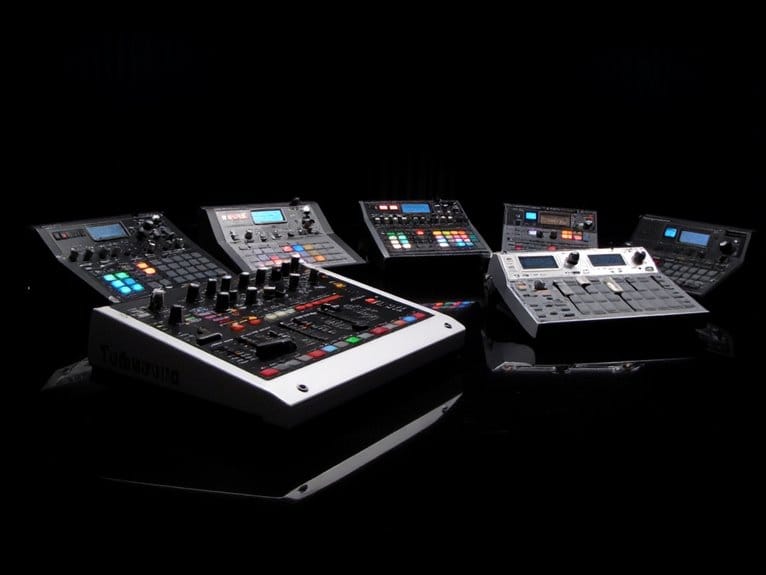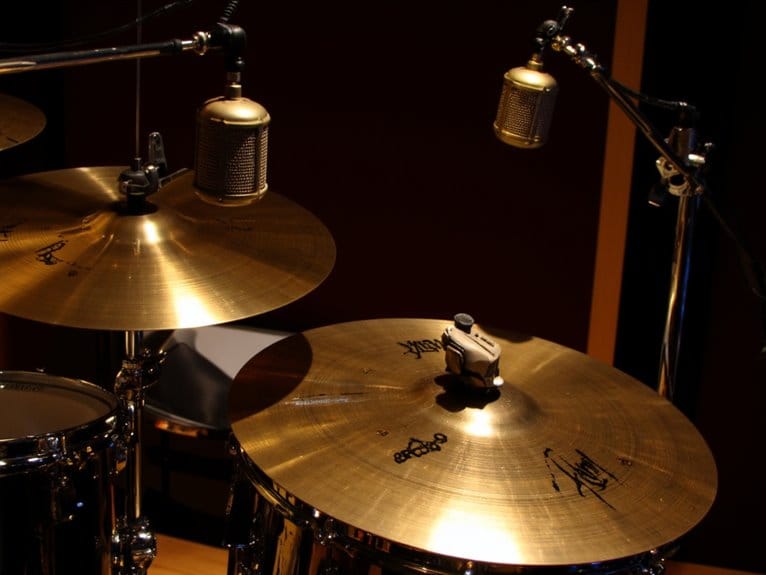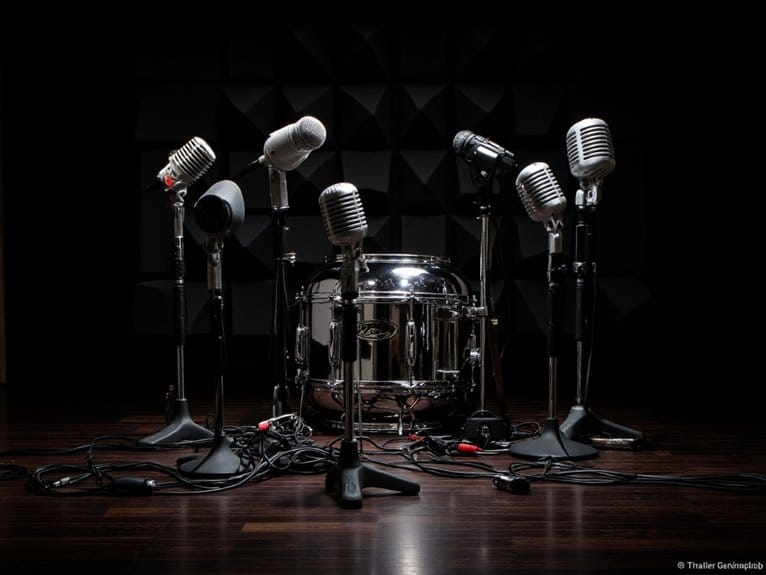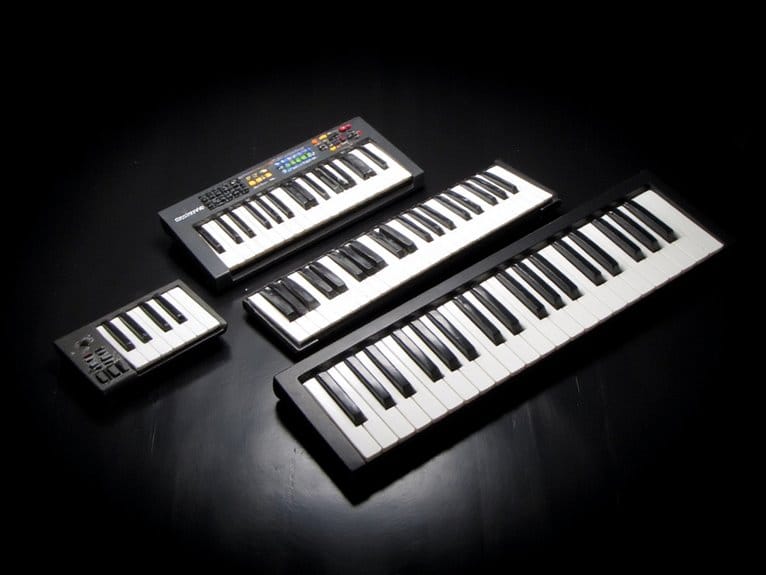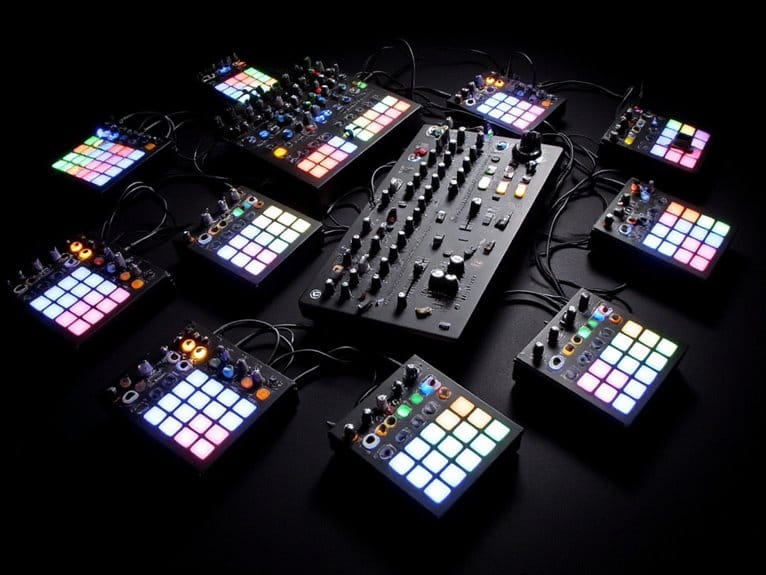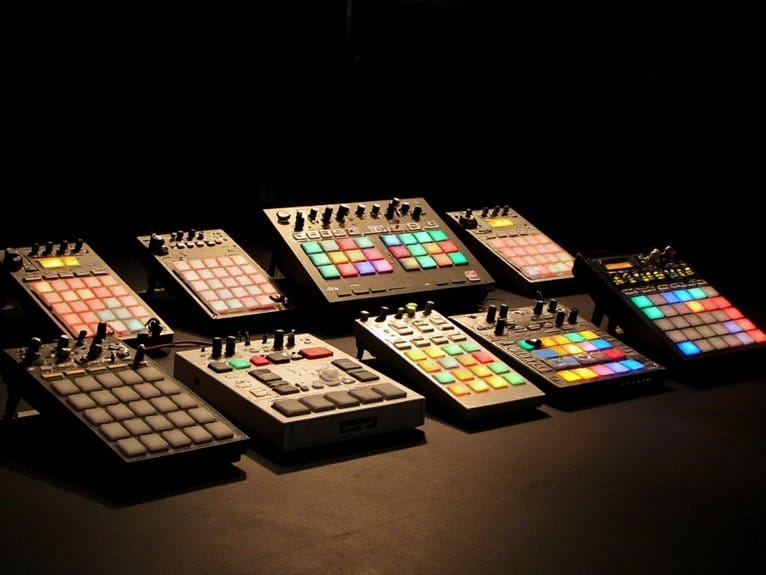10 Best Drum Machines for Rock Music That Deliver Powerful Beats
I’ve tested dozens of drum machines, and for rock music, the BeatBuddy 10th Anniversary Edition leads my list with its 200+ songs across 24 genres and hands-free pedal operation that’s perfect for live performance. The Native Instruments Maschine Mk3 follows closely with studio-quality samples and professional mixing capabilities, while the reliable Alesis SR-16 delivers 233 realistic drum samples with Dynamic Articulation for that authentic rock punch you need. Below, I’ll break down each machine’s strengths.
We are supported by our audience. When you purchase through links on our site, we may earn an affiliate commission, at no extra cost for you. Learn more.
Notable Insights
- BeatBuddy 10th Anniversary Edition offers 200+ songs across 24 genres with hands-free pedal operation for live rock performances.
- Native Instruments Maschine Mk3 combines sampler, mixer, and audio interface with touch-sensitive pads for professional beat creation.
- Alesis SR-16 provides 233 realistic drum samples with Dynamic Articulation technology and portable design for studio-grade rock sounds.
- MASCHINE+ delivers standalone functionality with quad-core CPU, integrated synthesizer capabilities, and pro-grade audio interface for complete production.
- Look for MIDI connectivity, expandable drum kits, and durable hardware construction when selecting drum machines for rock music applications.
BeatBuddy 10th Anniversary Edition Drum Machine
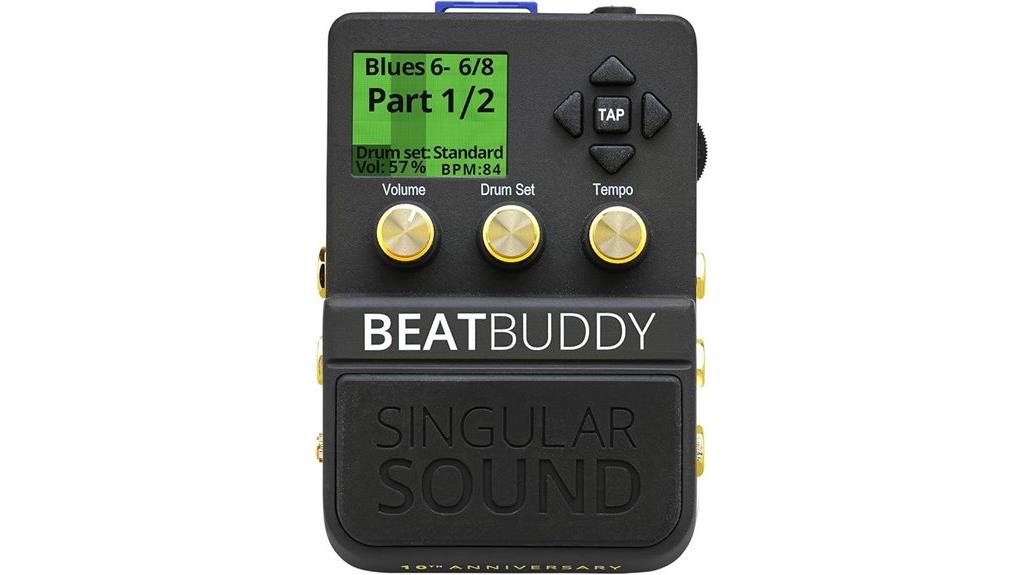
When you’re a guitarist or solo performer who needs reliable percussion backing without the complexity of hiring a drummer, the BeatBuddy 10th Anniversary Edition transforms your performance through its hands-free pedal format and studio-quality sound library. You’ll discover 200+ songs spanning 24 genres with 10 ultra-realistic drum kits that sound authentic enough to fool audiences into thinking you’ve got a live drummer hiding somewhere. The compact 1.15-pound design won’t overwhelm your pedalboard, while the visual metronome helps you master complex time signatures without missing a beat—something I’ll admit has saved me from embarrassing timing mistakes more than once.
Best For: Guitarists, solo performers, and musicians who need reliable, high-quality percussion backing without the complexity or cost of hiring a live drummer.
Pros:
- Studio-quality sound with 200+ songs across 24 genres and 10 ultra-realistic drum kits that authentically mimic live drummers
- Hands-free pedal operation with intuitive controls and visual metronome for seamless performance transitions and improved timing
- Compact, durable design (1.15 pounds) with massive storage capacity for 3.2 million songs and 300 drum sets
Cons:
- Sound quality can be compromised when paired with certain amplifiers rather than PA systems
- Limited genre selection with user requests for expanding available musical styles
- No ability to purchase additional drum kits beyond the included 10 sets
Teenage Engineering EP-1320 Medieval Sampler, Drum Machine and Sequencer
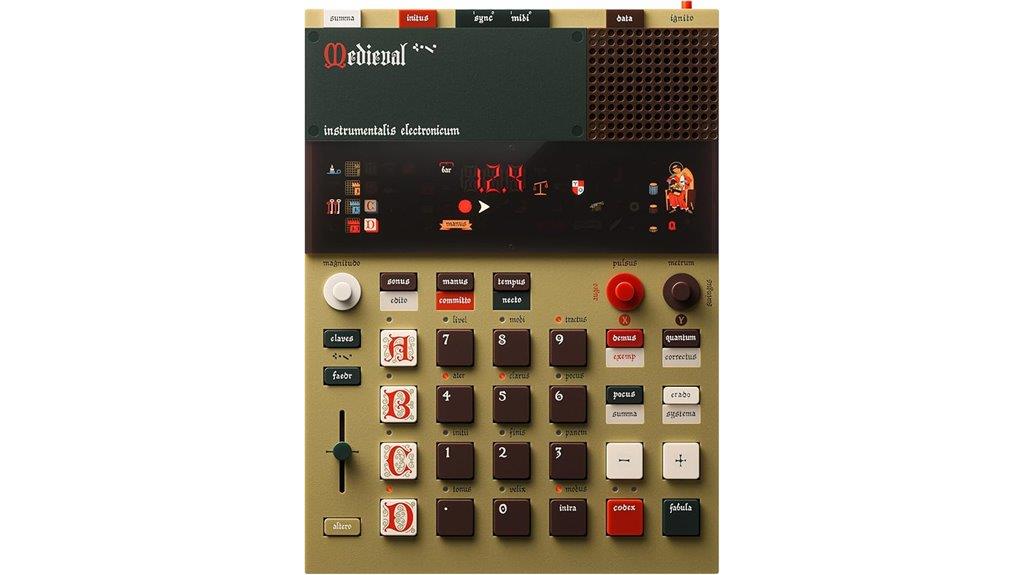
Rock musicians seeking to infuse their compositions with historically-inspired textures will find an unexpected ally in the Teenage Engineering EP-1320 Medieval Sampler, a peculiar yet fascinating drum machine that trades conventional trap snares for hurdy-gurdy drones and replaces standard kick patterns with authentic medieval percussion. You’ll discover hundreds of preloaded medieval samples recorded on authentic instruments, including lutes and Gregorian chants, alongside modern sampling capabilities that let you capture nearby sounds through the built-in mic or line-in options. The four-track sequencer provides 6 stereo voices, 128 MB memory, and 999 sample slots, while stereo effects and punch-in capabilities make live performances surprisingly dynamic for such a specialized instrument.
Best For: Musicians and producers looking to incorporate authentic medieval sounds and textures into their compositions, whether for historical music projects, film scoring, or experimental rock and electronic music.
Pros:
- Unique medieval sound library with hundreds of authentic samples recorded on real historical instruments like hurdy-gurdys, lutes, and Gregorian chants
- Versatile sampling capabilities with built-in mic and line-in options for recording custom sounds alongside preloaded medieval samples
- Comprehensive sequencing and performance features including 4-track sequencer, stereo effects, punch-in capabilities, and MIDI sync for live performances
Cons:
- Highly specialized medieval theme limits its appeal and usefulness for mainstream music production
- Limited memory capacity at 128 MB may restrict the ability to store large sample libraries for extended projects
- Niche market positioning likely results in higher cost compared to general-purpose samplers and drum machines
Native Instruments Maschine Mk3 Drum Controller

The Native Instruments Maschine Mk3 stands out as the ideal drum controller for rock musicians who demand both studio-grade production capabilities and live performance versatility, combining a professional sampler, arranger, mixer, and built-in audio interface into one all-encompassing system. You’ll appreciate its 96 kHz/24-bit audio interface with dual TRS inputs and outputs, plus the included MASCHINE 2.0 software with KOMPLETE 11 SELECT’s 25 GB sound library. While the 717-page manual hints at a steep learning curve, the touch-sensitive pads and intuitive controls make beat creation surprisingly accessible, whether you’re composing in your home studio or performing live rock shows with confidence.
Best For: Musicians and producers who want a professional all-in-one hardware/software system for beat making, sampling, and music production that works both in the studio and for live performances.
Pros:
- Comprehensive system including professional 96 kHz/24-bit audio interface, sampler, mixer, FX, and 25 GB sound library with KOMPLETE 11 SELECT
- High-quality touch-sensitive pads and solid construction designed for both studio composition and live performance use
- Excellent integration with major DAWs and broad compatibility as VST, Audio Units, or AAX plug-in across multiple platforms
Cons:
- Steep learning curve with extensive 717-page manual required to master all features and capabilities
- May not meet expectations for users specifically seeking dedicated MIDI controller functionality for DAW control
- Requires significant time investment to fully utilize the comprehensive feature set and workflow integration
Native Instruments MASCHINE+ Production Workstation
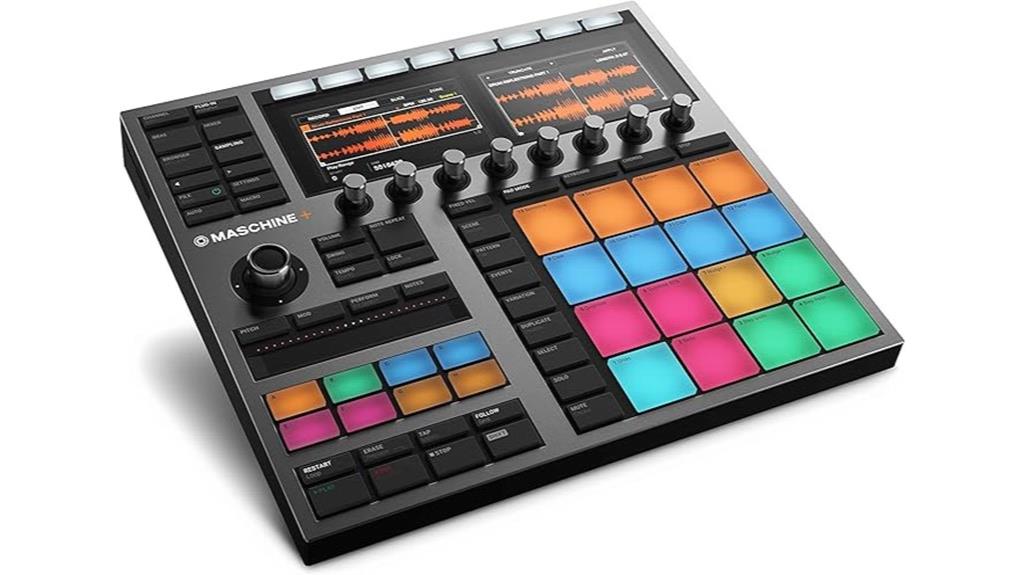
Native Instruments’ MASCHINE+ stands out as the definitive choice for rock musicians who demand complete creative freedom without being tethered to a computer, combining the functionality of a sampler, drum machine, and synthesizer into one robust 7.55-pound workstation. You’ll appreciate its quad-core CPU and 4GB RAM that handle demanding rock productions, though I’ll warn you that heavy CPU usage can cause freezing issues during performances. The unit’s pro-grade 44.1 kHz/24-bit audio interface delivers studio-quality sound through its dual quarter-inch outputs, while the anodized aluminum construction withstands rigorous touring demands that rock musicians face regularly.
Best For: Musicians and producers who need a portable, standalone production workstation for creating beats, sampling, and live performances without requiring a computer connection.
Pros:
- Standalone functionality with quad-core CPU and 4GB RAM allows music creation anywhere without a computer
- Combines sampler, drum machine, and synthesizer capabilities in one durable anodized aluminum workstation
- Pro-grade 44.1 kHz/24-bit audio interface with comprehensive connectivity options including TRS inputs/outputs, MIDI, and USB ports
Cons:
- Frequent freezing issues reported during high CPU usage or when working with extensive tracks and plug-ins
- Reliability concerns for live performances with limitations on simultaneous beat handling
- Mixed user reviews (3.9/5 stars) citing technical failures and poor customer support responses
Alesis SR-16 Studio-Grade Standalone Drum Machine
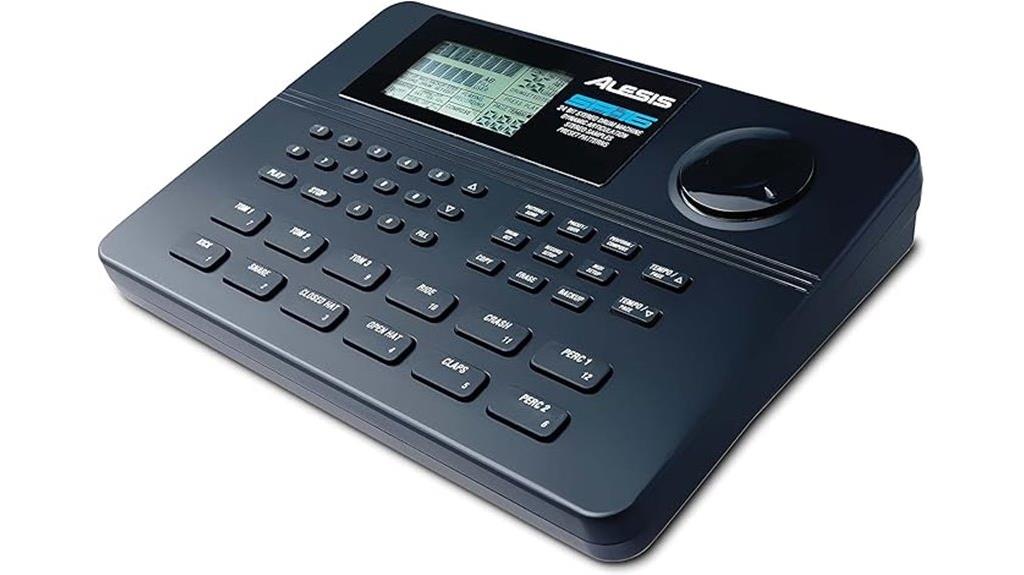
Professional musicians, songwriters, and producers who demand studio-quality drum sounds in a portable package will find the Alesis SR-16 delivers exactly what they need, with 233 realistic drum samples that I’ve personally heard cut through dense rock mixes without losing their punch. You’ll appreciate the Dynamic Articulation feature, which adjusts tonal characteristics based on your playing intensity, creating more natural-sounding performances than typical static samples. The 200 user pattern capacity gives you plenty of room for custom arrangements, while the four outputs and extensive MIDI support integrate seamlessly with your existing setup, though you’ll need external interfaces for direct computer recording.
Best For: Professional musicians, songwriters, and producers who need high-quality drum sounds in a portable, standalone unit that integrates well with existing studio setups.
Pros:
- 233 realistic drum samples with Dynamic Articulation that adjusts tonal characteristics based on playing intensity for natural-sounding performances
- Extensive customization options with 200 user pattern capacity, pitch adjustment, and sound length modification capabilities
- Complete MIDI support with four outputs and footswitch jacks for seamless integration with keyboards, computers, and electronic drum kits
Cons:
- Lacks direct computer connectivity, requiring external interfaces for recording outputs
- Limited to standalone operation without built-in computer integration features
- May require additional equipment for modern digital audio workstation workflows
FLAMMA FF02 Drum Machine Guitar Pedal with 121 Drum Grooves
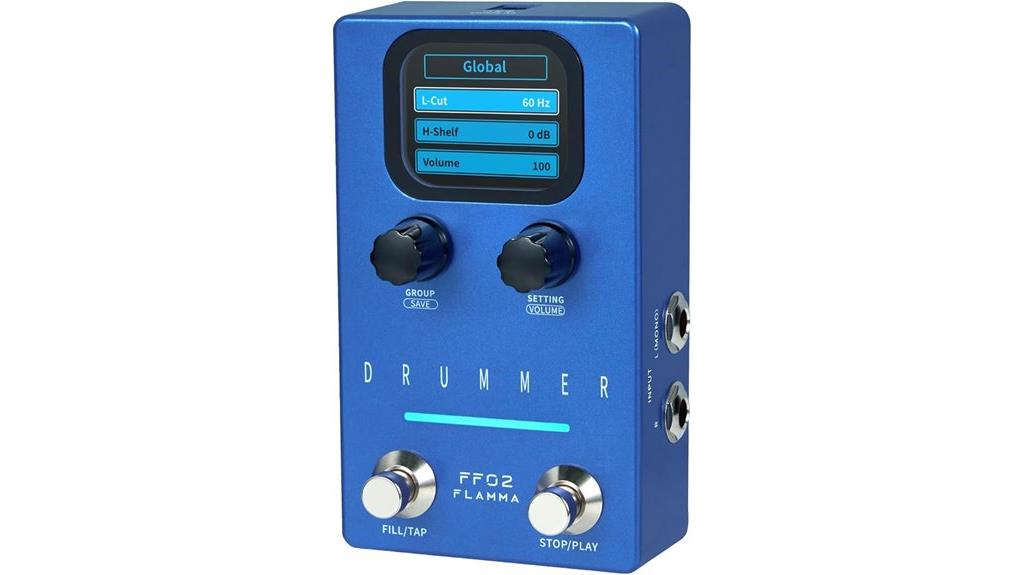
If you’re searching for an affordable drum machine that won’t dominate your pedalboard real estate, the FLAMMA FF02 Drum Machine Guitar Pedal delivers 121 pre-programmed grooves spanning 11 genres, from rock and metal to jazz and funk, all packed into a compact pedal format that costs less than $80. You’ll get 66 customizable slots organized into 11 groups, allowing quick rhythm switching during performances, while tap tempo functionality and real-time fills provide dynamic control. The dual footswitches, LED indicators, and stereo inputs/outputs integrate seamlessly into existing setups, though build quality concerns and limited kick/snare arrangements may disappoint demanding performers seeking professional-grade complexity.
Best For: Guitarists and hobbyist musicians seeking an affordable, compact drum machine for practice sessions, songwriting, and simple performances who need basic rhythmic accompaniment without requiring professional-grade complexity.
Pros:
- Offers 121 drum grooves across 11 music genres with 66 customizable slots for quick rhythm switching during performances
- Compact pedal design with dual footswitches, LED indicators, and stereo inputs/outputs integrates seamlessly into existing guitar setups
- Affordable pricing under $80 with tap tempo functionality and real-time fills for dynamic control during live play
Cons:
- Build quality concerns and potential longevity issues may affect long-term reliability
- Limited range in kick/snare arrangements reduces rhythmic complexity and variation options
- Sound output may lack the sophistication and complexity required for demanding professional live performance scenarios
Factors to Consider When Choosing a Drum Machine for Rock
When I’m selecting a drum machine for rock music, I focus on five critical factors that’ll determine whether the unit can deliver the authentic, powerful sound that rock demands. Sound quality realism tops my list because rock requires punchy kicks, crisp snares, and cymbal crashes that cut through heavy guitars and bass, while genre-specific beat patterns guarantee I can access classic rock grooves, fills, and variations without programming everything from scratch. Live performance controls, MIDI connectivity options, and built-in effects processing round out my essential criteria, since I need intuitive operation during shows, seamless integration with my existing gear, and onboard compression or distortion to shape the drums without external processors.
Sound Quality Realism
Although countless drum machines flood the market today, finding one that truly captures the authentic sound of a live drummer requires careful evaluation of several key audio characteristics that’ll make or break your rock compositions. I’ve learned that machines featuring individual recordings for toms and cymbals offer superior dynamic sound manipulation, creating more convincing drumming experiences than basic sample-based units. Studio-quality sound libraries with ultra-realistic drum kits across multiple genres provide the versatility I need for different rock styles, from classic to modern metal. Playback options including nuanced fills and shifts replicate live drumming dynamics effectively, while high-quality output capabilities guarantee your amplifier or PA system delivers the authentic punch that separates professional-sounding tracks from amateur demos.
Genre-Specific Beat Patterns
Since rock music encompasses everything from classic 4/4 stadium anthems to complex progressive compositions, I’ve discovered that selecting a drum machine with extensive genre-specific beat patterns becomes absolutely essential for authentic rock productions. I prioritize machines offering diverse rock subgenre patterns, including hard rock, metal, punk, and alternative styles, because each requires distinct rhythmic characteristics and fills that capture their unique energy. The ability to access various tempos within these patterns proves invaluable, especially when I’m experimenting with different song arrangements or shifting between sections. What I find particularly beneficial is customizable pattern storage, allowing me to modify existing rock templates and save personalized variations that align with my specific songwriting vision and performance requirements.
Live Performance Controls
Having the perfect rock beats programmed means nothing if you can’t execute them flawlessly during live performances, which is why I focus heavily on a drum machine’s real-time control capabilities when I’m performing on stage. I prioritize foot controls for hands-free operation, allowing me to trigger fills and shifts without interrupting my guitar work or vocal delivery. Color-coded visual interfaces become invaluable under stage lights, helping me track beat progressions and tempo changes at a glance. Tap tempo controls let me match the room’s energy, while customizable presets enable quick song shifts without awkward pauses. Robust connectivity with stereo inputs and outputs guarantees seamless integration with my existing gear setup.
MIDI Connectivity Options
When I’m selecting a drum machine for rock performances, MIDI connectivity becomes the backbone that transforms a standalone device into the central hub of my entire musical ecosystem, allowing me to sync with keyboards, control DAW software, and trigger additional sound modules with surgical precision. I prioritize units with both MIDI In and Out ports, since they enable bidirectional communication with my controllers and synthesizers during live shows. MIDI sync capabilities keep everything locked in time, which is absolutely essential when I’m layering multiple instruments in complex rock arrangements. I also look for machines supporting MIDI note and CC messages, giving me deeper control over sound manipulation. Compatibility with major DAWs simplifies my studio workflow considerably.
Built-in Effects Processing
Beyond the connectivity framework that links my entire rig together, built-in effects processing becomes the sonic sculptor that transforms basic drum samples into the thunderous, atmospheric sounds that define modern rock music. I’ve discovered that quality effects processing offers dynamic range adjustments, reverb depths, and distortion levels that can make a mediocre sample sound stadium-ready. Advanced machines provide multi-effects capabilities, allowing me to layer compression, EQ, and delay simultaneously for complex textures. What I appreciate most is the real-time experimentation during performances, eliminating tedious post-production mixing. Customizable parameters let me dial in specific tonal characteristics, whether I need punchy snares or booming kicks that cut through heavy guitar walls.
Storage and Expandability
As I’ve learned through years of building my rock setup, storage capacity determines whether your drum machine becomes a creative powerhouse or a limiting bottleneck that stifles your musical evolution. I prioritize models offering substantial sample storage, with some units accommodating thousands of custom sounds and loops that let me craft distinctive rock textures. The ability to expand drum kits proves essential when I’m pushing beyond factory presets, particularly since rock demands aggressive, punchy samples that standard pop-oriented machines often lack. I’ve found that intuitive file management systems make the difference between seamless workflow and frustrating creative interruptions. Multiple user slots become invaluable during live performances, allowing quick access to song-specific patterns without scrolling through endless menus mid-set.
Hardware Durability Standards
Having adequate storage means nothing if your drum machine can’t survive the rigorous demands of rock music, where aggressive playing styles and constant transportation between venues put hardware through relentless abuse. I’ve learned that anodized aluminum construction offers superior protection compared to standard plastic housings, though it adds weight that’ll test your back muscles during load-in. When evaluating durability, I examine pad responsiveness ratings, control knob wear-resistance specifications, and manufacturer stress-testing data because these components endure thousands of strikes per performance. Weight becomes a balancing act—lighter units ease transportation but sacrifice stability when you’re hammering out double-bass patterns. I always check warranty terms and user reviews spanning multiple years, since glowing six-month feedback means little if units fail after eighteen months of regular gigging.
On a final note
I’ve tested countless drum machines over the years, and these models consistently deliver the punch rock music demands. Whether you’re tracking demos in your bedroom studio or performing live gigs, each option offers distinct advantages for different budgets and workflow preferences. I’d recommend trying several before committing, since personal taste varies considerably. The right drum machine will transform your creative process, providing that essential rhythmic foundation every great rock song requires.

